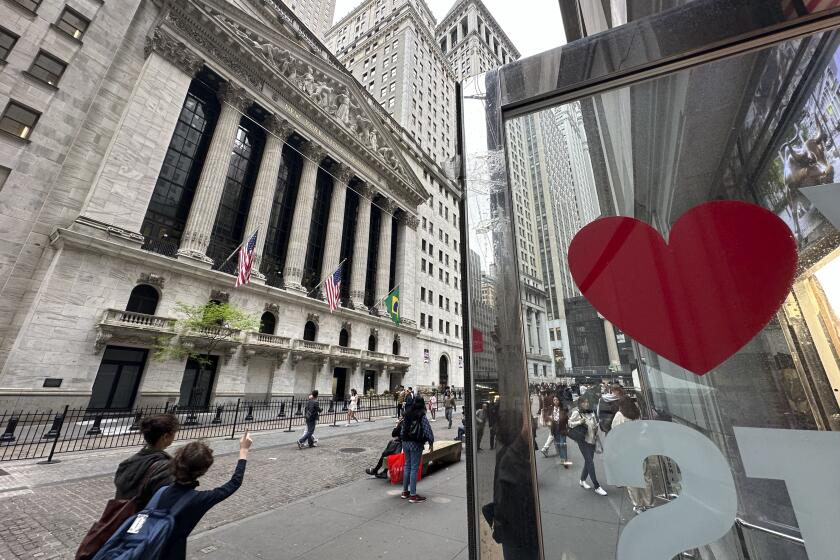Bond Rater Gives State a Little Credit
For the first time in nearly four years, California’s worst-in-the-nation credit standing went up Friday instead of down.
Citing a recovering economy, higher tax revenues and the likelihood that the Legislature and Gov. Arnold Schwarzenegger will agree on a new budget, Moody’s Investors Service moved the state back from the brink of junk-bond status.
By upgrading the state’s general obligation bond rating to A3 from Baa1, Moody’s displayed a new confidence in the direction of California government.
If followed by the other Wall Street rating companies, the action could save California taxpayers millions of dollars in interest on current and future debt.
But don’t uncork the champagne just yet: California’s rating remains lower than that of any other state.
“We’re still quite low, well below average,” said Tim Blake, an analyst for Moody’s in New York.
The three major rating agencies, Moody’s, Standard & Poor’s and Fitch Ratings, collect fees for analyzing the risks involved in various securities. A higher rating indicates less risk to investors.
Moody’s highest rating is Aaa -- a status California last enjoyed in 1989.
Fitch and S&P; continue to rank California as BBB. That and the fact that Moody’s new rating is only as high as the state’s credit ranked last August reflects the continuing fiscal challenge, particularly a sizable structural budget deficit.
Several prominent economists cautioned that the continuing imbalance between state revenues and expenditures could discourage Wall Street from lifting the rating much higher.
Moody’s action brought relief in Sacramento.
Schwarzenegger called the upgrade “fantastic news” and said he appreciated the “strong vote of confidence” from Moody’s.
“Their financial analysts have had a chance to carefully review our revised budget and our economic outlook and they’ve concluded that it warrants an improvement in California’s standing in the nation’s financial markets,” he said.
The Republican governor pointedly noted that the Legislature still needed to approve a balanced and responsible state budget on time, before the start of the new fiscal year July 1.
Moody’s has dropped the state’s credit rating five times since May 2001. After the stock market bubble burst that year, state revenues fell sharply. Moody’s dropped the rating from Aa2 to Aa3, citing increased financial risks associated with an electricity crisis that forced the state to buy power for financially strapped private utilities.
California’s chronic deficit spending and reliance on borrowing, as well as the use of one-time revenues and accounting gimmicks, led to further declines. Finally, Schwarzenegger’s decision to repeal an increase in vehicle license fees sent the rating to near the bottom of investment-grade securities.
Moody’s said Friday it was raising the state’s rating because of recent improvement in the economy and tax revenues.
“We feel confident calling it an established trend of economic recovery,” Blake said.
The growth in jobs and personal income has boosted the state’s income tax and sales tax revenues. Another boost in receipts came from a tax amnesty program for high-income taxpayers.
Moody’s decision to upgrade the state also reflects California’s ability to repay $14 billion in short-term borrowing that comes due in mid-June.
That change in financial fortunes is due largely to California voters’ approval in March of a ballot measure authorizing the sale of up to $15 billion in bonds to refinance much of the budget deficit that built up in recent years. The state raised cash by selling $7.9 billion in deficit bonds earlier this month.
Moody’s new credit rating applies to about $35 billion in outstanding general obligation bonds -- securities backed by general tax revenues. The deficit bonds, however, already carry a higher rating because they are backed by a dedicated share of sales tax revenues.
Based on agreements that the governor has reached with key education and local government groups, Moody’s expects adoption of Schwarzenegger’s 2004-05 budget to be “more politically feasible than earlier proposals.”
State Treasurer Phil Angelides said achieving ongoing structural balance in the budget is necessary for the state to restore a strong credit rating.
The state’s other financial officer, Controller Steve Westly, said the ratings upgrade was “a clear sign California is on the road back.”
However, he joined the chorus of those who say that lawmakers and the governor must solve the state’s long-term structural deficit.
“We’ve taken our lumps on Wall Street over the last few years, and it sure feels good to be up off the mat. We can’t stop here,” Westly said.
Michael J. Bazdarich, a senior economist for the UCLA Anderson Forecast, agreed that the state’s economy is showing signs of improvement. But he expressed doubt that it will produce enough tax revenue in coming years to eliminate shortfalls.
“Nobody in Sacramento has the stomach to cut spending,” he said.
Joseph Hurd, another senior economist for the UCLA Anderson Forecast, cautioned that the state’s economy has had only two good months in a row. “We are not off to the races like we were in the ‘90s,” he said.
Steve Levy, director of the Palo Alto-based Center for the Continuing Study of the California Economy, said simply: “Moody’s must be concentrating on the short term.”
Analyst David Hitchcock at Standard & Poor’s in New York said the revised budget that Schwarzenegger presented last week shows some improvement, but added that “the economic recovery alone is not enough to get to structural balance” in the state budget.
S&P; analysts want to see the budget passed by the Legislature before considering any change in its BBB rating for California.
Hitchcock offered a perspective about where the state stands. “The reason why we are talking about upgrades is because the rating is so low right now,” he said.






